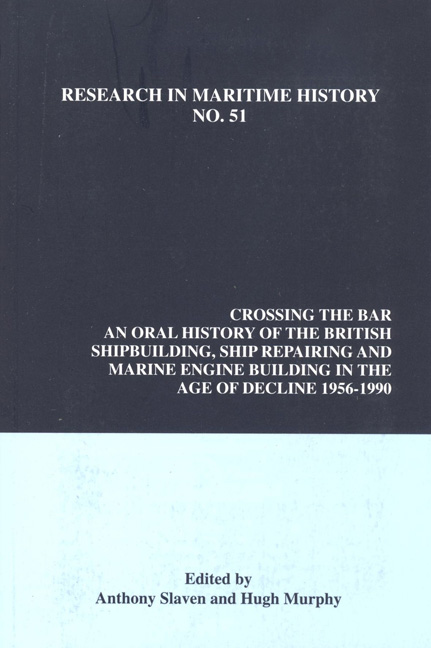 Crossing the Bar
Crossing the Bar Book contents
- Frontmatter
- Contents
- About the Authors
- Dedication
- Preface: A Shipbuilding Libretto
- Introduction
- Interviews
- Lower Clyde
- Upper Clyde
- 4 Sir Eric Yarrow, Weir Engineering, Cathcart, Yarrow Shipbuilders
- 5 Dr. Brian Baxter, Yarrow Shipbuilders
- 6 Bob Easton, Yarrow Shipbuilders
- 7 Sandy Stephen, Alexander Stephen Shipbuilders and Engineers
- 8 Professor John Rorke, Alexander Stephen, Denny Brothers, Brown Brothers
- 9 Fred Walker, Denny Brothers, Fairfield, Connell and Hall Russell
- 10 Jolyon Slogett, Denny Brothers, Houlder Bros., British Shipbuilders Plc
- 11 Dr. John Brown, John Brown, Clydebank
- 12 Graham Strachan, Alexander Stephen, John Brown and Scott Lithgow
- 13 J.F. Starks, John Brown, Upper Clyde Shipbuilders
- 14 Anthony Hepper, Upper Clyde Shipbuilders
- 15 Harry Osborne, Civil Engineer
- The Tyne
- The Wear
- Barrow-in-Furness
- The South Coast
- The Humber
- Belfast
- British Shipbuilding Industry Officials
- The Trade Unions
- The Civil Servants, Board of Trade, Shipbuilding Enquiry Committee, Shipbuilding Industry Board, Ministry of Technology, Department of Trade and Industry, Department of Industry
- The Politicians
- Interviews British Shipbuilders Plc
- Conclusion
- Select Bibliography
13 - J.F. Starks, John Brown, Upper Clyde Shipbuilders
from Upper Clyde
- Frontmatter
- Contents
- About the Authors
- Dedication
- Preface: A Shipbuilding Libretto
- Introduction
- Interviews
- Lower Clyde
- Upper Clyde
- 4 Sir Eric Yarrow, Weir Engineering, Cathcart, Yarrow Shipbuilders
- 5 Dr. Brian Baxter, Yarrow Shipbuilders
- 6 Bob Easton, Yarrow Shipbuilders
- 7 Sandy Stephen, Alexander Stephen Shipbuilders and Engineers
- 8 Professor John Rorke, Alexander Stephen, Denny Brothers, Brown Brothers
- 9 Fred Walker, Denny Brothers, Fairfield, Connell and Hall Russell
- 10 Jolyon Slogett, Denny Brothers, Houlder Bros., British Shipbuilders Plc
- 11 Dr. John Brown, John Brown, Clydebank
- 12 Graham Strachan, Alexander Stephen, John Brown and Scott Lithgow
- 13 J.F. Starks, John Brown, Upper Clyde Shipbuilders
- 14 Anthony Hepper, Upper Clyde Shipbuilders
- 15 Harry Osborne, Civil Engineer
- The Tyne
- The Wear
- Barrow-in-Furness
- The South Coast
- The Humber
- Belfast
- British Shipbuilding Industry Officials
- The Trade Unions
- The Civil Servants, Board of Trade, Shipbuilding Enquiry Committee, Shipbuilding Industry Board, Ministry of Technology, Department of Trade and Industry, Department of Industry
- The Politicians
- Interviews British Shipbuilders Plc
- Conclusion
- Select Bibliography
Summary
I started at the age of fifteen as a shipwright apprentice at Devonport Dockyard, and managed to get a Royal Scholarship in Engineering at London University. At nineteen, I became a Constructor Sub-Lieutenant, and did three years at the Naval College in Greenwich getting a first class Certificate in Naval Architecture. When the war began, I was sent to the Admiralty establishment at Bath, as an Assistant Constructor in the Submarine Design Office, and I attended all the sea trials of submarines built at Vickers. Before the war was over I was appointed a Constructor Commander on the staff of the Royal Naval Mission in Washington DC, working with the US Navy. After three and a half years there I returned to Bath, where I became a Chief Constructor. After five years, John Brown's asked me to become a director, and I eventually joined them in 1960, after the launch of the Dreadnought [Britain's first nuclear- powered submarine] as Technical Director and Chief Naval Architect. I spent from 1960 to 1972 with Brown's and latterly with UCS with whom I was a Technical Director. Prior to that, I had been made Deputy Managing Director at Clydebank. When UCS hit the rocks, at the age of fifty-five I joined Vosper Thornycroft in Southampton to become their representative in Rio de Janeiro for five years before I retired.
The primary strength of John Brown was our reputation, fully justified, as builders of large passenger ships. It was also a good firm in that it could build anything. We had also a very good design team and a fine Joiner's Shop. We had very good relations with the owners, and I must emphasise that our reputation was enhanced by the Queen Mary and the Queen Elizabeth, which were tremendous assets during the war as troop carriers. The standard of workmanship was high. I think our prices were high, but so was our quality. For instance, the Royal Yacht, Britannia was built at Clydebank.
To come to the weaknesses; I think there were too few top men. There was the Managing Director, the Shipyard Director, Engineering Director, Technical Director and a Finance Director. There were only five of us and we worked too hard. We tried to do too much.
- Type
- Chapter
- Information
- Crossing the BarAn Oral History of the British Shipbuilding, Ship Repairing and Marine Engine-Building Industries in the Age of Decline, 1956-1990, pp. 51 - 54Publisher: Liverpool University PressPrint publication year: 2013


